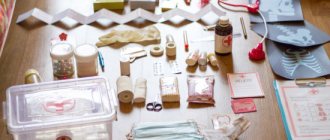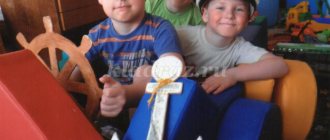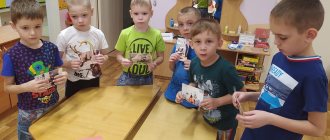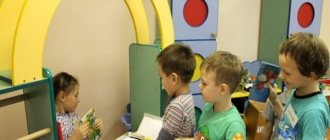MAGAZINE Preschooler.RF
Summary of a plot-role-playing game of patriotic content for children of the middle group “Children’s Clinic”Author: teacher: Sokolova N.V. Municipal autonomous preschool educational institution kindergarten “Smile” Malinovsky village
2021
The relevance of the problem of organizing this plot-role-playing game for patriotic education lies in the fact that the formation of moral and patriotic values and beliefs of the personality of a preschool child occurs in the plot-role-playing game as the leading activity for a given age. It is in the joint play activities of children that the prerequisites for collective relationships and the ability to act in the interests of others are created. The pedagogical potential of role-playing games as a means of developing patriotic feelings in children of senior preschool age lies in the moral and value plot, the content of the game and role-playing relationships in which the child shows moral and patriotic feelings, understands and masters the norms of moral and patriotic behavior. Playing a role in the game “Children's Clinic” provides each child with the opportunity to show and develop patriotic qualities - respect for working people, pride in their hard work, empathy for loved ones, concern for their health. The game “Children's Clinic” stimulates these feelings and qualities in children. It is also important that role-playing game allows you to correct the behavior of older preschoolers, making it more and more conscious and subordinate to the moral norms and rules accepted in society.
Goal: to increase the level of development of gaming skills and the quality of role-playing dialogues on the topic of the game.
Tasks:
Educational:
- expand children’s play plans, teach them to take on different roles in accordance with the plot of the game;
- arouse interest in the medical profession, a desire to learn more about medical workers, and give an idea of the need to take care of one’s health;
- learn to distribute roles and use dialogic speech to prepare the conditions necessary for the game;
- consolidate role-playing dialogue skills in the game.
Educational:
- develop ways of showing patriotic feelings in the game;
- develop perception, thinking, memory, attention, imagination, coherent speech, cognitive interest, creativity, will, emotions;
- enrich children's speech experience with various types of dialogue cues;
- develop the ability to communicate kindly, without conflicts.
Educational:
- cultivate a respectful attitude towards people in medical professions;
- to cultivate moral and patriotic feelings of humanism, care for loved ones, their health, and empathy.
Integration of regions (according to Federal State Educational Standards of Education):
Social and communicative development - nurturing love for the Motherland, pride in its achievements, and patriotic feelings.
Cognitive development – development of children’s interests, curiosity and cognitive motivation; formation of cognitive actions, formation of consciousness; development of imagination and creative activity; formation of primary ideas about oneself and other people.
Speech development – enrichment of active vocabulary; development of coherent, grammatically correct dialogical and monologue speech.
Artistic and aesthetic development is the implementation of independent creative visual and constructive activities of children in the manufacture of attributes and equipment for a role-playing game.
Physical development – development of general and fine motor skills; formation of healthy lifestyle values, mastery of its elementary norms and rules.
Vocabulary work: enriching the vocabulary of nouns (head physician, pediatrician, nurse, medicine, prescription, thermometer, temperature, tests, appetite, diagnosis, treatment, etc.); dictionary of verbs (complain, feel, measure, check, pass (tests); dictionary of antonyms of adjectives (healthy - sick, good - bad (appetite), hot - cold, active, cheerful - inactive, lethargic, etc.), antonyms of adverbs (good - bad, calm - restless).
Equipment:
Real objects: tables, chairs, couches.
Game material: doll first aid kits, dolls.
Plates with the names of the rooms: chief physician, pediatrician, treatment room.
For doctors: phonendoscope, prescriptions, white coats, caps.
For the nurse: medical records, thermometers, white coat and cap, syringes, jars, medicine boxes.
Demonstration material: posters about a healthy lifestyle, the benefits of vitamins, and hardening.
Preliminary work:
- The teacher's story and conversation about the profession of a doctor, nurse, about the work of doctors of different specialties (therapist, pediatrician, ophthalmologist, surgeon, dentist, etc.).
- Observing the work of a nurse and a doctor in a kindergarten.
- Reading an excerpt about the doctor from Mayakovsky’s poem “Who to be?” , fiction: V. Suteev “About a hippopotamus who was afraid of vaccinations. K. Chuikovsky “Aibolit” , S. Mikhalkov “Vaccination” , Wonderful pills”, Y. Shigaev “I am a nurse today” .
- Examination of the plot pictures “The work of different doctors in the hospital .
- Watching animated films: based on V. Suteev “About a hippopotamus who was afraid of vaccinations. K. Chuikovsky "Aibolit" .
- Preparation of attributes, equipment and materials for playing in joint activities of children and adults (teacher, parents).
- Preparing the play area - hanging signs with the name of the clinic premises, posters about a healthy lifestyle, the benefits of vitamins, hardening, distribution of play material, arrangement of equipment, etc.
Individual work:
Help children change role behavior depending on the plot and negotiate with each other during the game.
Invite some children to change roles during the game.
Encouraging participation in dialogues: asking to ask questions, answering questions from the teacher and other children.
Stimulate with praise, verbal encouragement for an inactive child, give him advice, tips, a model of role behavior and remarks.
Contain a hyperactive child by giving him additional tasks related to the plot of the game so that he can direct his energy to completing them.
Structure and methodological techniques.
The structure includes 4 stages:
- motivational;
- organizational (distribution of roles and discussion of game actions);
- main (playing the game);
- final (reflection and summing up).
Methodical techniques:
- gaming (imaginary situation, plot concept, distribution of roles, etc.)
- visual (if necessary, the teacher can show how to perform this or that game action, for example, listen to the patient’s breathing, give an injection, etc.)
- The teacher guides the game using direct and indirect methods. Direct leadership: the teacher takes on the role of the head physician and directly tells children playing different roles what to do and how. Indirect guidance: the teacher observes the game, gives advice, recommendations, offers different options for developing the plot, and praises the children.
To independently motivate children to play, the teacher, as a leader, performs the following tasks in the game:
- To teach children flexible role-playing behavior when developing a story-based game in individual and joint activities with peers.
- Learn to use role-playing dialogue.
- Help children change role behavior depending on the plot and negotiate with each other during the game.
Problem: supporting children's initiative and developing playful actions when organizing the role-playing game "Children's Clinic" with a patriotic focus.
Expected Result:
- Children’s level of development of gaming skills and the quality of role-playing dialogues on the topic of the game will increase;
- Children’s play plans will expand, they will learn to take on different roles in accordance with the plot of the game;
- interest in the medical profession will increase, and an understanding of the need to take good care of one’s health will be formed;
- will learn to distribute roles and use dialogic speech to prepare the conditions necessary for the game;
- children will master ways of demonstrating patriotic feelings in the game;
- perception, thinking, memory, attention, imagination, coherent speech, cognitive interest, creative abilities, emotional-volitional sphere will receive further development;
- children will learn to communicate kindly, without conflicts;
- the level of respect for people in medical professions and moral and patriotic feelings (humanism, care for loved ones, their health, empathy) will increase.
Rough plan.
- Motivating children to play – 1 min..
- Distribution of roles and discussion of role actions – 2 min.
- Performing role-playing actions based on the plot of the game – 15 min.
- Reflection and summing up the game. Children’s ratings of what they liked, what needs to be added to the game – 2 min.
Progress of the lesson:
1. Motivating children to play – 1 min.
Educator:
- Children, guess the riddle:
If your health is bad, you feel unimportant, here the doctors will help you. This building is... (Hospital).
- Well done, you guessed correctly.
— Guys, I read some wonderful news on the Internet today. A new children's clinic has opened in our city (village). This is a modern large building, very good specialists work in it: doctors, nurses.
- Imagine that you and I, sitting on a train, plane or ship, are moving further and further from home, and suddenly we have a toothache, a sore throat, an earache, a high temperature, of course, we can take medicine with us. But it is better to set off healthy. To do this, you need to see a doctor and undergo a medical examination.
– Where can this be done?
– Who works in the children's clinic?
– What doctors do you know?
Children's answers: pediatrician, surgeon, ENT, ophthalmologist, orthopedist, etc.
Educator:
- Come on, guys, you and I will become doctors, nurses and open our own children's clinic.
2. Organizational stage – 2 min.
The center of the game is in the kindergarten group.
Distribution of roles.
Educator: In our clinic, I will be the chief physician.
— What does the head physician do?
Children's answers: the head doctor will manage everyone and check the work, he must be serious, responsible, smart.
The head physician asks:
– What does a pediatrician do? Answers: looks at the throat, takes the temperature, prescribes treatment.
– What does an ophthalmologist do? Answers: checks vision, prescribes glasses if necessary, treats eyes, prescribes drops.
– What does a surgeon do? Answers: checks whether legs and arms hurt, treats bruises, contusions, prescribes massage, physical therapy.
— We also have a nurse. What is she doing?
Answers: Brings medical records of patients, takes their temperature before seeing a doctor. She gives injections, vaccinations, and issues certificates.
Distribution of roles and discussion of role actions.
The teacher asks the children to take the initiative and name the roles in the game.
Roles: head physician (educator), pediatrician, nurse, patients came to the clinic for an appointment - mother and daughter, father and son (daughter and son are dolls).
The teacher asks the children to name role-playing actions.
He himself adds the children’s answers in accordance with the table. Roles
| Role-playing activities | |
| Chief physician | Hires medical workers. Organizes work, controls, talks with patients. |
| Pediatrician | Receives the patient, listens, listens, prescribes treatment, writes prescriptions for medications. Gives advices. Issues sick leave. |
| Nurse | Takes patients' temperatures before admitting them to their doctor's appointments. Follows doctor's orders - gives injections, takes tests. Talks with patients. Washes tools. |
| Patients (parents with children. Children are dolls) | They come to see a doctor with a coupon and medical card. They talk about the child’s condition, show what hurts, what worries him. Follow all advice and doctor's prescriptions. |
3. Main stage. Performing role-playing actions based on the plot of the game – 15 min.
The head physician announces:
– Our children's clinic opens today. Welcome. Patients take coupons from the reception desk and go to the doctors' offices. They take a turn. They go to see a pediatrician.
Near the pediatrician’s office, a nurse comes out and asks the child’s (doll’s) last name, first name, and how old he is. He brings the medical card and gives it to the doctor. Provides patients with thermometers to measure their temperature before being examined by a doctor.
At the pediatrician's appointment. Mom and daughter come in. “child” feels and why they came to the clinic.
The doctor conducts an examination, makes a diagnosis, prescribes treatment and a prescription for medications.
The nurse makes notes in the medical record. As prescribed by the doctor, he gives an injection or takes tests - in a separate room.
At the end of the examination, the mother and daughter thank the doctor and nurse, leave the office, and go home. A new patient comes in for an appointment - a father and his son.
FRAGMENTS OF A GAME WITH DIALOGUES
The patient enters the clinic, surrenders his clothes, takes a number and goes to the reception desk.
Patient:
- Hello. Please give me a doctor's certificate (my child's medical card).
Nurse:
– Please give your child’s last name, first name, patronymic, home address, date of birth.
The patient names the data, takes a coupon (medical card) and goes to the doctor’s office. (The nurse can bring the medical card into the doctor’s office herself).
“Mom” with “child” visits the therapist’s office.
The nurse asks to see a doctor.
Mom: Hello.
Doctor: Hello, come in, sit down. What worries you? Tell me in detail, don't rush.
Mom: We are going to visit, the road is long. And in order not to get sick on the road, I would like you to examine my child.
Doctor (examines the child: checks the throat, listens to the lungs, heart, measures the temperature). He says: “You are healthy, but you definitely need to get vaccinated .
The doctor turns to the child: Do you know why you need to get vaccinated?
Child's answer.
Doctor: There are a lot of microbes in everything that surrounds us - both beneficial and harmful. And in order not to catch a dangerous disease, it is necessary to get vaccinated. The treatment nurse administers the vaccinations and tries to make sure no one gets hurt. And so that you don’t get sick and are always healthy, I will treat you with vitamins.
The child and mother thank the doctor.
The nurse asks to see a doctor.
Patient: Hello.
Doctor: Hello, come in, sit down. What worries you.
Patient: I wanted to check my vision.
The doctor examines the patient, checks his vision.
Doctor: You have a slight redness, this is caused by overwork. The eyes are a very important and delicate organ. During the day, your eyes get tired. I'll prescribe you drops to relieve redness and glasses for watching TV, they will help your eyes not to become overstrained.
(The nurse writes a prescription, the doctor puts a stamp and his signature) The patient goes to the pharmacy.
Final stage – 2 min..
Reflection.
The teacher asks questions:
- Guys, did you like our children's clinic?
– Did the doctor perform her duties conscientiously? Were you polite to patients? How did the nurse work?
— Did you like your role in the game?
— Which role is the most interesting?
- What new did you learn?
Summing up the game. Children take part in the discussion of the game. They evaluate the ability to play together, role-playing dialogues and joint actions in the game.
The teacher asks questions:
— What did you like about the game?
— What role would you like to play next time?
— What should be added to the game?
GAME DEVELOPMENT IN PERSPECTIVE
The game can be continued for 2-3 days. New roles are gradually being added - a receptionist who issues coupons for doctor's appointments, medical specialists, a nurse in the treatment room, a salesperson at a pharmacy kiosk, a taxi driver-courier who delivers medicines and medical equipment to the clinic, he can also bring patients to the clinic and take them them back home, etc. In accordance with the new roles, game attributes are added, the subject-spatial environment is replenished or changed.
| < Previous | Next > |



